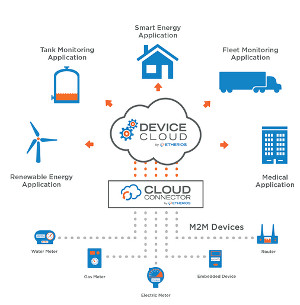The Device Connection Platform from Ericsson is a cloud service for machine-to-machine and Internet-of-Things applications, which is specifically aimed at enabling telecommunications network operators to offer connectivity management to their business customers in the IoT/M2M sector.
This new platform enables mobile network operators to provide support services for a growing variety of IoT and M2M devices, as well as simplifying the process of large-scale IoT network deployment and reducing costs. Ericsson has recently acquired this M2M platform from Telenor Connexion, in an effort to build their technology and know-how in this growing sector. Telenor Connexion will become Ericsson’s first customer for the Device Connection Platform.
Ericsson’s DCP is a dedicated M2M/IoT platform aimed at enterprise IoT users that handles connectivity management, subscription management and integration with Operations Support and Business Support Systems. It also allows for automation of business processes between mobile operators and business enterprises.
The platform is sold as a cloud service, offering users the traditional cloud benefits of a low initial investment and a fast rollout – that can significantly reduce barriers to deployment of IoT/M2M solutions by cellular network operators and their customers, keeping the total cost of ownership down while maximising quality of service.
Ericsson’s platform supports network operators who are expanding their M2M and IoT business sectors by assisting with connectivity management across the whole device lifecycle, as well as assisting with the marketing of DCP-based services. Furthermore, the platform provides valuable functions such as subscription management, device management, and self-service Web-based administration portals for both operators and enterprise users. Ericsson’s offering is comprised of the basic Platform-as-a-Service functionality along with service portals and APIs for users.
By offering a range of APIs, Ericsson allows enterprise customers to integrate their back-end systems and processes with this M2M platform – allowing these back-end systems to access the data and capabilities of M2M/IoT networks.
Through a service portal, available at any time from anywhere, customers can access self-service functionality to manage and control their installed SIM cards, monitor operational status in real time, access analytics data, and perform other management functions.
Ericsson’s platform aims to make it more viable for device manufacturers, enterprises and service providers to deploy large Internet-of-Things solutions across geographical boundaries, and has already been implemented by some telecom providers abroad such as Orange, TeliaSonera and Bell Canada.
Multinational enterprises offering connected M2M/IoT services and devices to an international customer base are faced with a key challenge – how to provide an easily managed and seamless IoT solution for end users as they move between different providers and different mobile networks.
The fragmentation of mobile networks between different countries and different carriers is a major obstacle to global M2M deployments. However with Ericsson’s platform – the goal is for operators and their customers to enjoy a unified experience in large-scale mobile IoT deployments, including global use of a single SIM card, harmonised service levels and harmonised business processes, across multiple countries and multiple network operators.
Ericsson, together with the Global M2M Association – a cooperative effort between six international tier-one operators active in the M2M telecommunications market, have showcased their new Multi-Domestic Service at Mobile World Congress 2015.
The Multi-Domestic Service aims to address this issue of network fragmentation across different carriers and countries by delivering a single, consolidated M2M/IoT management platform, based on Ericsson’s Device Connection Platform. Three of the Global M2M Association’s members (Orange, Telia and Bell) have already started using the Device Connection Platform individually.
Orange Business Services have also recently announced that they have entered into a strategic agreement with Ericsson to use the Device Connectivity Platform. As with Ericsson’s other partners for this platform, their goal is to better serve the growing global M2M market and to respond to the need for multi-domestic connectivity with seamless user experience across different carrier networks in many countries.
As well as the cross-border mobile IoT efforts of the Global M2M association, the Device Connection Platform is also going to be adopted to support connectivity, security and device management by members of the Asia-centric Bridge Alliance of mobile carriers.

The Bridge Alliance aims to use the Device Connectivity Platform to lower the barriers to entry into IoT services for device OEMs and service providers across 36 different countries that are covered by the member companies in the alliance, with the goal of common end-user experience and back-end management.
Furthermore, the Bridge Alliance hopes to remove the need for complicated deals that businesses would otherwise have to negotiate with national telecommunications network carriers in each country they’re operating in, and enable them to create multi-national platforms and processes to support IoT services and devices that can seamlessly “roam” internationally and between different operators.
Considering the effort Ericsson has expended into the platform, along with the efforts of the Global M2M association – this new platform could be the solution to your M2M and IoT device needs.
Here at the LX Group we have end-to-end experience and demonstrated results in the entire process of IoT product development, and we’re ready to help bring your existing or new product ideas to life. Getting started is easy – click here to contact us, telephone 1800 810 124, or just keep in the loop by connecting here.
LX is an award-winning electronics design company based in Sydney, Australia. LX services include full turnkey design, electronics, hardware, software and firmware design. LX specialises in IoT embedded systems and wireless technologies design.
Published by LX Pty Ltd for itself and the LX Group of companies, including LX Design House, LX Solutions and LX Consulting, LX Innovations.

